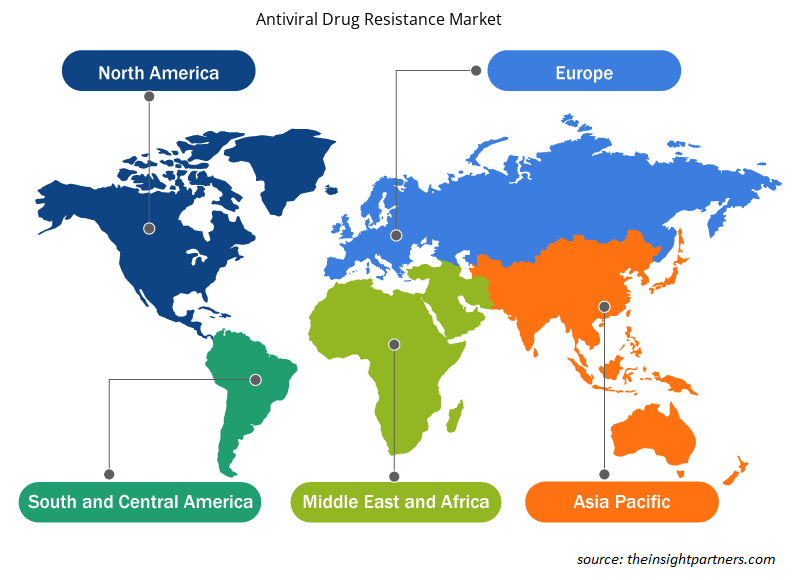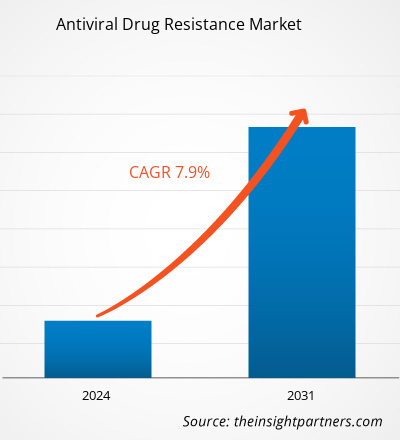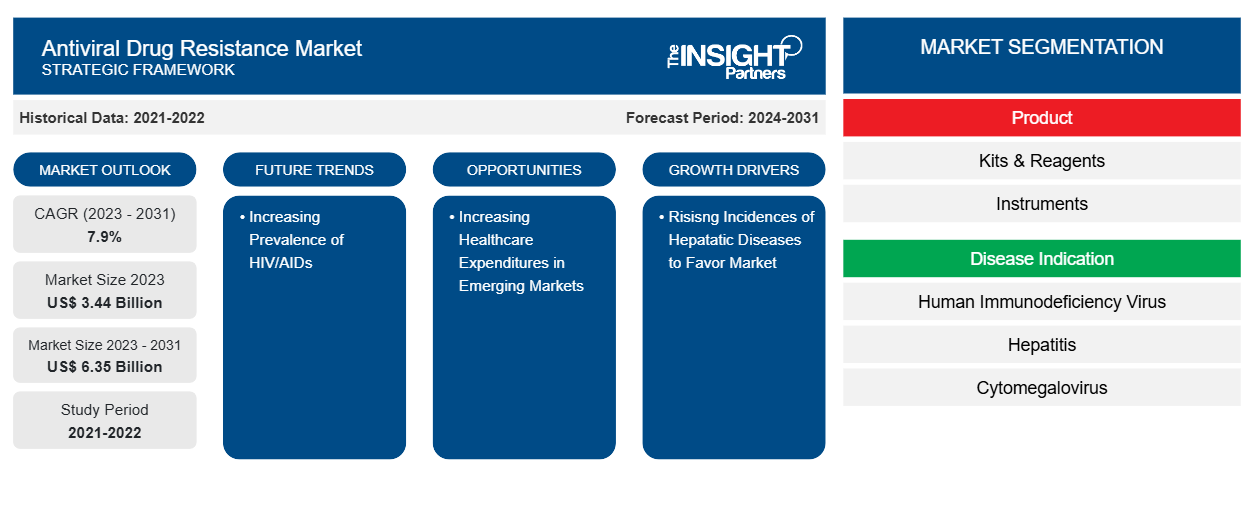Der Markt für antivirale Arzneimittelresistenzen soll von 3,44 Milliarden US-Dollar im Jahr 2023 auf 6,35 Milliarden US-Dollar im Jahr 2031 anwachsen. Für den Zeitraum 2023–2031 wird ein durchschnittliches jährliches Wachstum von 7,9 % erwartet. Die steigende Zahl von Lebererkrankungen, die Verbreitung von HIV und AIDS sowie die Nachfrage nach qualitativ hochwertigen Produkten in Schwellenländern dürften weiterhin wichtige Trends auf dem Markt bleiben.
Marktanalyse für antivirale Arzneimittelresistenz
Die Prävalenz von HIV/AIDS hat in den letzten Jahren weltweit zugenommen. Das erworbene Immunschwächesyndrom (AIDS) ist eine chronische, potenziell lebensbedrohliche Erkrankung, die durch ein menschliches Immunschwächevirus (HIV) verursacht wird. Das Virus ist für die Schädigung des Immunsystems verantwortlich, wobei HIV die Fähigkeit des Körpers beeinträchtigt, die krankheitserregenden Organismen zu bekämpfen. Wenn HIV in den Körper eindringt, entwickelt sich innerhalb eines Monats eine grippeähnliche Erkrankung. Diese Krankheit wird als primäre oder akute HIV-Infektion bezeichnet und kann einige Wochen andauern. Laut den Daten des US-Gesundheitsministeriums und des Minority AIDS Initiative Fund (SMAIF) des Ministers lebten im Jahr 2022 weltweit etwa 39 Millionen Menschen mit HIV/AIDS. Eine große Mehrheit der Menschen mit HIV lebt in Ländern mit niedrigem und mittlerem Einkommen. Laut dem Bericht India HIV Estimation 2017 (National Informatics Centre) wird die HIV-Prävalenz in Indien beispielsweise auf 0,22 % (0,16 %–0,30 %) geschätzt. Darüber hinaus wird die HIV-Prävalenz bei Erwachsenen auf 0,25 % (0,18 %-0,34 %) bei Männern und auf 0,19 % (0,14-0,25) bei Frauen geschätzt. Daher wird erwartet, dass die Fälle von Virusinfektionen im Land die Nachfrage nach dem Markt für antivirale Arzneimittelresistenzen im Prognosezeitraum ankurbeln werden.
Marktübersicht zur Resistenz gegen antivirale Medikamente
Der Anstieg der Fälle von Hepatitis- Erkrankungen und die zunehmende Verbreitung von HIV/AIDS kurbeln das Wachstum des Marktes im Laufe der Jahre an. Auch der Anstieg des Schwellenmarktes dürfte sich im Prognosezeitraum positiv auf die Nachfrage nach dem Markt auswirken. Das Wachstum des Marktes wird jedoch durch Faktoren wie alternative Ansätze gebremst. Die Verbreitung von HIV in den USA hat in den letzten Jahren zugenommen. Laut den vom US-Gesundheitsministerium bereitgestellten und vom Minority AIDS Initiative Fund (SMAIF) des Ministers unterstützten Daten wurden im Jahr 2021 fast 32.100 Amerikaner neu mit HIV infiziert. Daher wird erwartet, dass die oben genannten Faktoren das Wachstum des nordamerikanischen Marktes für antivirale Arzneimittelresistenz im Prognosezeitraum ankurbeln werden.
Passen Sie diesen Bericht Ihren Anforderungen an
Sie erhalten kostenlos individuelle Anpassungen an jedem Bericht, einschließlich Teilen dieses Berichts oder einer Analyse auf Länderebene, eines Excel-Datenpakets sowie tolle Angebote und Rabatte für Start-ups und Universitäten.
-
Holen Sie sich die wichtigsten Markttrends aus diesem Bericht.Dieses KOSTENLOSE Beispiel umfasst eine Datenanalyse von Markttrends bis hin zu Schätzungen und Prognosen.
Treiber und Chancen des Marktes für antivirale Arzneimittelresistenz
Steigende Fälle von Lebererkrankungen begünstigen den Markt
Viren sind winzige Keime, die verschiedene Infektionskrankheiten wie Grippe, Erkältung und Warzen verursachen können. Viren können auch schwere Krankheiten wie Pocken, HIV/AIDS und Ebola verursachen. Viren vermehren sich in Zellen und können in jede lebende, gesunde Zelle eindringen, sich vermehren und andere Viren wie sich selbst produzieren. Verschiedene Viren greifen bestimmte Zellen im Körper an, wie Leber, Gehirn, Haut, Blut sowie Fortpflanzungs-, Atmungs- und Magen-Darm-Systeme. Die Prävalenz von Virusinfektionen wie Hepatitis hat in den letzten Jahren weltweit zugenommen. Hepatitis verursacht Leberschäden und Entzündungen, die auch andere Organe schädigen können. Es ist ein großes globales Gesundheitsproblem, das chronische Infektionen verursachen und auch das Sterberisiko durch Leberzirrhose und Leberkrebs erhöhen kann. Hepatitis kann in die Kategorien A, B, C, D und E eingeteilt werden, die sich durch unterschiedliche Ursachen verbreiten. Nach Angaben der WHO (Weltgesundheitsorganisation) ist die Prävalenz von Hepatitis B in der afrikanischen und westpazifischen Region am höchsten, wo 6,1 % bzw. 6,2 % der erwachsenen Bevölkerung infiziert sind.
Steigende Gesundheitsausgaben in Schwellenländern
Die steigenden Gesundheitsausgaben in Schwellenländern wie dem asiatisch-pazifischen Raum sowie Süd- und Mittelamerika ermöglichen es Forschern, Behandlungsmöglichkeiten für eine breite Palette von Viruserkrankungen zu entwickeln, indem sie fortschrittliche Techniken wie PCR (Polymerase-Kettenreaktion), Sequenzierung der nächsten Generation und andere einsetzen. Mehrere Organisationen wie das National Cancer Institute (NCI) finanzieren HIV- und AIDS-Malignitätsforschung, um zu untersuchen, wie sich das Altern bei chronischen HIV-Infektionen auf das Risiko, das Spektrum und die Biologie von Krebs auswirkt. China, Japan, Brasilien und andere Schwellenländer geben viel Geld für das Gesundheitswesen aus, um ihre Präsenz auf dem Markt zu etablieren und den angemessenen Einsatz von Instrumenten und Reagenzien sicherzustellen, die in Krankenhäusern und Forschungsinstituten, pathologischen Labors und anderen Einrichtungen in ihren jeweiligen Ländern verwendet werden.
Marktbericht zur Resistenz gegen antivirale Medikamente – Segmentierungsanalyse
Wichtige Segmente, die zur Ableitung der Marktanalyse zur antiviralen Arzneimittelresistenz beigetragen haben, sind Typ, Krankheitsindikation, Technologie und Endbenutzer.
- Der Markt für antivirale Arzneimittelresistenzen ist nach Typ in Kits, Reagenzien und Instrumente unterteilt. Das Segment Kits und Reagenzien hatte im Jahr 2023 den größten Marktanteil.
- Nach Krankheitsindikation ist der Markt in HIV, Hepatitis und Cytomegalovirus (CMV) segmentiert. Das HIV-Segment hatte im Jahr 2023 den größten Marktanteil.
- Technologisch ist der Markt in Immundiagnostik, Polymerase-Kettenreaktion (PCR), Next-Generation-Sequencing (NGS) und andere segmentiert. Das Segment Immundiagnostik hielt im Jahr 2023 einen erheblichen Marktanteil.
- Basierend auf den Endverbrauchern ist der Markt für antivirale Arzneimittelresistenz in Krankenhäuser und Kliniken, Pathologie- oder Diagnoselabore und Forschungsinstitute unterteilt. Das Segment Krankenhäuser und Kliniken hatte im Jahr 2023 den größten Marktanteil.
Marktanteilsanalyse für antivirale Arzneimittelresistenz nach geografischer Lage
Der geografische Umfang des Marktberichts zur antiviralen Arzneimittelresistenz ist hauptsächlich in fünf Regionen unterteilt: Nordamerika, Asien-Pazifik, Europa, Naher Osten und Afrika sowie Süd- und Mittelamerika. Nordamerika hat geografisch den größten Marktanteil am Markt für Nasenkanülen mit hohem Durchfluss. Die Nachfrage auf diesem Markt wird im Prognosezeitraum voraussichtlich aufgrund verschiedener Faktoren wie der Verbreitung von Virusinfektionen wie HIV und Hepatitis, der Existenz nationaler Programme und der Finanzierung durch staatliche Stellen stark wachsen. Die Verbreitung von HIV in den USA hat in den letzten Jahren zugenommen. Laut den Daten des US-Gesundheitsministeriums, die vom Minority AIDS Initiative Fund (SMAIF) des Ministers unterstützt werden, wurden im Jahr 2021 fast 32.100 Amerikaner neu mit HIV infiziert. Der Asien-Pazifik-Raum wird in den kommenden Jahren voraussichtlich die höchste CAGR aufweisen.
Regionale Einblicke in den Markt für antivirale Arzneimittelresistenz
Die regionalen Trends und Faktoren, die den Markt für antivirale Arzneimittelresistenzen im Prognosezeitraum beeinflussen, wurden von den Analysten von Insight Partners ausführlich erläutert. In diesem Abschnitt werden auch Marktsegmente und Geografien für antivirale Arzneimittelresistenzen in Nordamerika, Europa, im asiatisch-pazifischen Raum, im Nahen Osten und Afrika sowie in Süd- und Mittelamerika erörtert.

- Erhalten Sie regionale Daten zum Markt für antivirale Arzneimittelresistenz
Umfang des Marktberichts zur Resistenz gegen antivirale Medikamente
| Berichtsattribut | Details |
|---|---|
| Marktgröße im Jahr 2023 | 3,44 Milliarden US-Dollar |
| Marktgröße bis 2031 | 6,35 Milliarden US-Dollar |
| Globale CAGR (2023 - 2031) | 7,9 % |
| Historische Daten | 2021-2022 |
| Prognosezeitraum | 2024–2031 |
| Abgedeckte Segmente |
Nach Produkt
|
| Abgedeckte Regionen und Länder |
Nordamerika
|
| Marktführer und wichtige Unternehmensprofile |
|
Dichte der Marktteilnehmer im Bereich antivirale Arzneimittelresistenz: Auswirkungen auf die Geschäftsdynamik verstehen
Der Markt für antivirale Arzneimittelresistenz wächst rasant, angetrieben durch die steigende Endverbrauchernachfrage aufgrund von Faktoren wie sich entwickelnden Verbraucherpräferenzen, technologischen Fortschritten und einem größeren Bewusstsein für die Vorteile des Produkts. Mit steigender Nachfrage erweitern Unternehmen ihr Angebot, entwickeln Innovationen, um die Bedürfnisse der Verbraucher zu erfüllen, und nutzen neue Trends, was das Marktwachstum weiter ankurbelt.
Die Marktteilnehmerdichte bezieht sich auf die Verteilung der Firmen oder Unternehmen, die in einem bestimmten Markt oder einer bestimmten Branche tätig sind. Sie gibt an, wie viele Wettbewerber (Marktteilnehmer) in einem bestimmten Marktraum im Verhältnis zu seiner Größe oder seinem gesamten Marktwert präsent sind.
Die wichtigsten Unternehmen auf dem Markt für antivirale Arzneimittelresistenz sind:
- AccuBioTech Co., Ltd.;
- ACON Laboratories, Inc.;
- Siemens AG;
- BioMérieux SA;
- Bio-Rad Laboratories, Inc.;
- Danaher;
Haftungsausschluss : Die oben aufgeführten Unternehmen sind nicht in einer bestimmten Reihenfolge aufgeführt.

- Überblick über die wichtigsten Akteure auf dem Markt für antivirale Arzneimittelresistenz
Neuigkeiten und aktuelle Entwicklungen zum Markt für antivirale Arzneimittelresistenz
Der Markt für antivirale Arzneimittelresistenz wird durch die Erhebung qualitativer und quantitativer Daten aus Primär- und Sekundärforschung bewertet, die wichtige Unternehmensveröffentlichungen, Verbandsdaten und Datenbanken umfassen. Nachfolgend sind einige der Entwicklungen auf dem Markt für antivirale Arzneimittelresistenz aufgeführt:
- – Die Janssen Pharmaceutical Companies von Johnson & Johnson (Janssen) gaben heute die Veröffentlichung neuer Daten in der Fachzeitschrift Nature bekannt, die zeigen, dass ein klinischer Kandidat im frühen Stadium (JNJ-1802) einen starken Schutz gegen Dengue bei nichtmenschlichen Primaten und Mäusen bietet. Das erste antivirale Mittel seiner Klasse, das sich in einer klinischen Phase-1-Studie am Menschen als sicher und gut verträglich erwies, wird nun in die klinischen Studien der Phase 2 zur Vorbeugung und Behandlung von Dengue überführt. (Quelle: Johnson & Johnson, Pressemitteilung, März 2023)
- Cipla Limited gab bekannt, dass es vom Drug Controller General of India (DCGI) eine Notfallzulassung (EUA) für die Markteinführung von Molnupiravir im Land erhalten hat. Cipla plant, Molnupiravir unter dem Markennamen Cipmolnu® auf den Markt zu bringen. Molnupiravir ist das erste orale antivirale Mittel, das von der britischen Medicines and Healthcare products Regulatory Agency (MHRA) zur Behandlung von leichtem bis mittelschwerem COVID-19 mit hohem Risiko für die Entwicklung schwerer Krankheitsverläufe zugelassen wurde. (Quelle: Cipla, Pressemitteilung, Mai 2021)
Marktbericht zur Resistenz gegen antivirale Medikamente – Umfang und Ergebnisse
Der Bericht „Marktgröße und Prognose zur antiviralen Arzneimittelresistenz (2021–2031)“ bietet eine detaillierte Analyse des Marktes, die die folgenden Bereiche abdeckt:
- Marktgröße und Prognose für antivirale Arzneimittelresistenz auf globaler, regionaler und Länderebene für alle wichtigen Marktsegmente, die im Rahmen des Berichts abgedeckt sind
- Markttrends zur antiviralen Arzneimittelresistenz sowie Marktdynamik wie Treiber, Einschränkungen und wichtige Chancen
- Detaillierte PEST/Porters Five Forces- und SWOT-Analyse
- Marktanalyse zur Resistenz gegen antivirale Medikamente, die wichtige Markttrends, globale und regionale Rahmenbedingungen, wichtige Akteure, Vorschriften und aktuelle Marktentwicklungen umfasst
- Branchenlandschaft und Wettbewerbsanalyse, die die Marktkonzentration, Heatmap-Analyse, prominente Akteure und aktuelle Entwicklungen auf dem Markt für antivirale Arzneimittelresistenz umfasst
- Detaillierte Firmenprofile
- Historische Analyse (2 Jahre), Basisjahr, Prognose (7 Jahre) mit CAGR
- PEST- und SWOT-Analyse
- Marktgröße Wert/Volumen – Global, Regional, Land
- Branchen- und Wettbewerbslandschaft
- Excel-Datensatz
Aktuelle Berichte
Verwandte Berichte
Erfahrungsberichte
Grund zum Kauf
- Fundierte Entscheidungsfindung
- Marktdynamik verstehen
- Wettbewerbsanalyse
- Kundeneinblicke
- Marktprognosen
- Risikominimierung
- Strategische Planung
- Investitionsbegründung
- Identifizierung neuer Märkte
- Verbesserung von Marketingstrategien
- Steigerung der Betriebseffizienz
- Anpassung an regulatorische Trends























 Kostenlose Probe anfordern für - Markt für antivirale Arzneimittelresistenz
Kostenlose Probe anfordern für - Markt für antivirale Arzneimittelresistenz